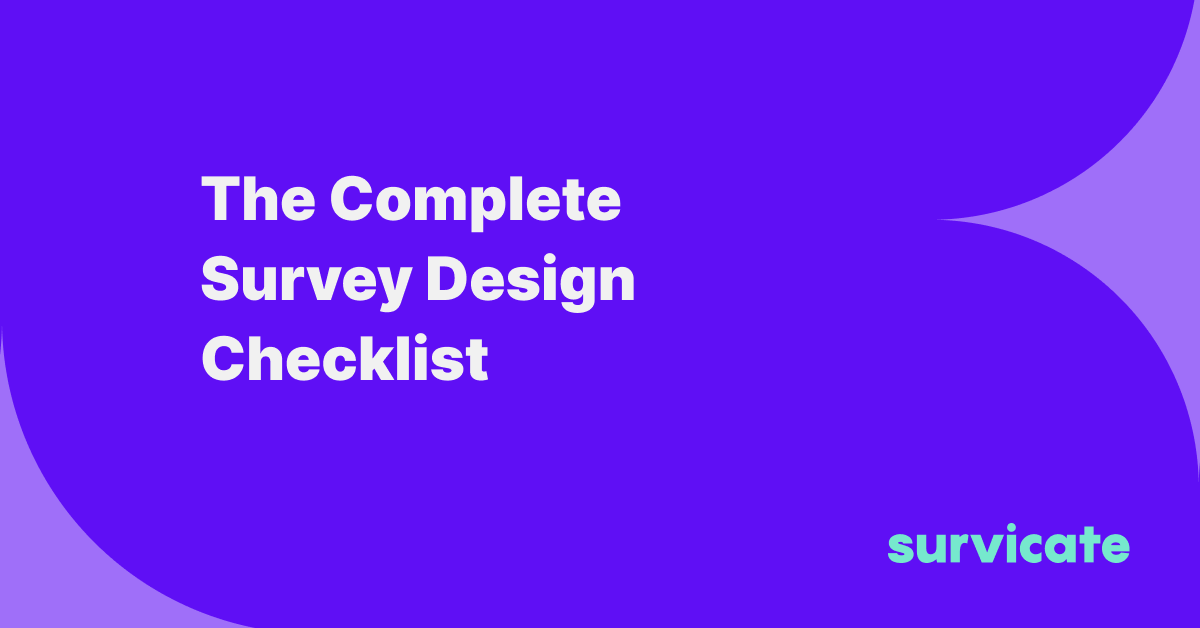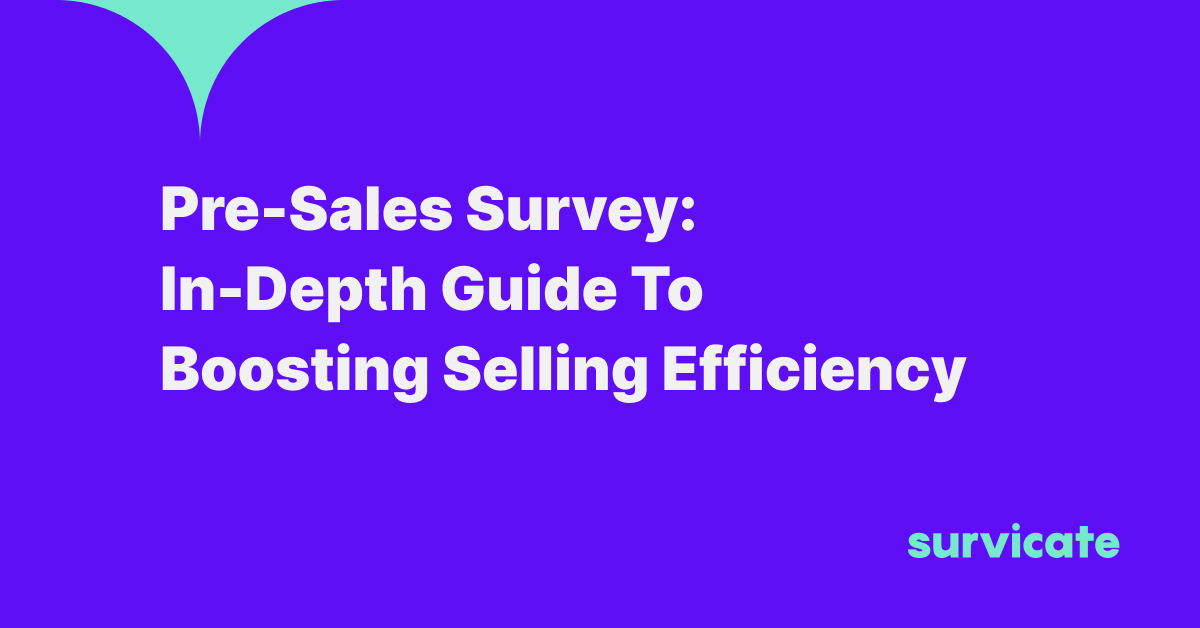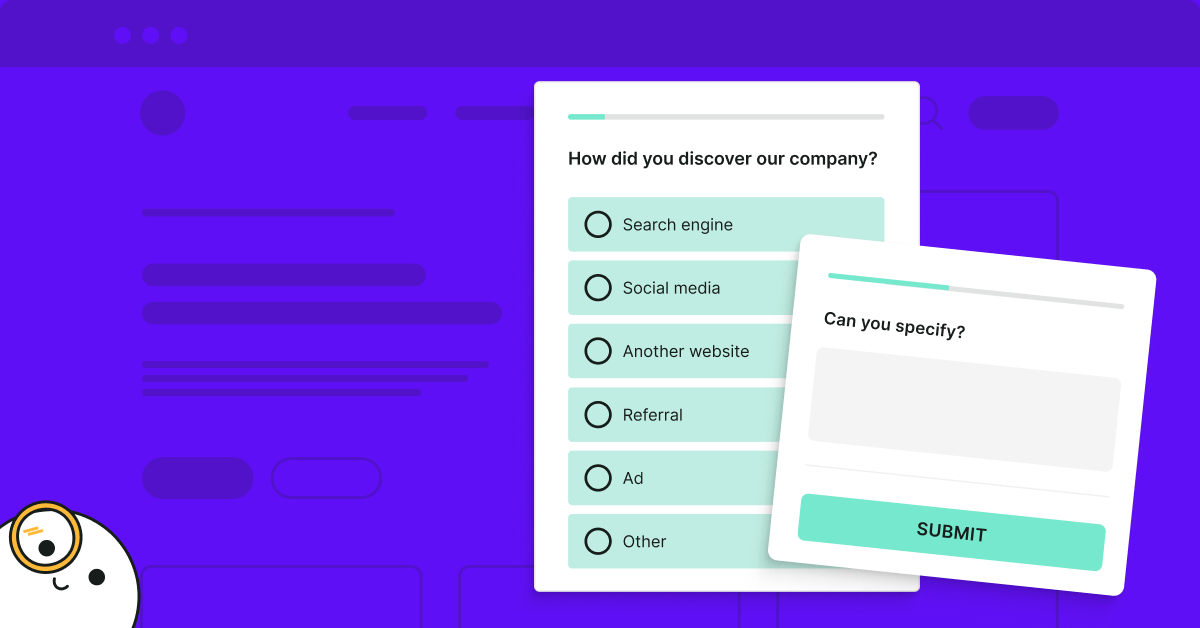Information is power. This goes for verified information, not assumptions.
Too frequently we base our decisions on our own beliefs, which leads to mistakes. We think about what we like and what we would do, but the truth is, it doesn’t work this way.
Especially in a business setting, making decisions based on assumptions can turn into a huge waste of budget. Imagine advertising on Instagram, when all your potential customers are on Twitter!
It’s important to collect and use your customers' feedback. And using these survey ideas you can find out more about your customers than you’d think.
Come up with some innovative surveys or pick from among 400+ ready templates and start receiving data within minutes.
10 creative survey ideas
While you may not think about doing surveys for fun, a creative and even humorous approach may boost your response rate.
Here are 10 creative survey ideas that you can draw inspiration from to make better business decisions while keeping your customer base entertained.
The templates are ready to send, but if you want to customize them, it only takes a few clicks with Survicate.
So, what can you use surveys for?
For marketers
1. Figure out how well you design your ads
According to our research, marketers waste about 26% of their budget. That’s why it makes sense to test your ads before you launch your campaign.
This advertising survey template can help you check whether the ad you created is going to be memorable to your potential audience.
2. Ask brand advocates to endorse you on G2
Word of mouth is the most effective form of marketing. Customers trust other people more than they trust brands. Word of mouth marketing results in 5 times more sales than paid media. 90% of people say they're more likely to buy from brands their friends recommend.
And G2 is a review platform that gets traffic of about 5 million visits a month. Use our template to benefit from positive reviews.
3. See what kind of content your customers enjoy
If you run a blog then you realize how difficult it is to continuously come up with new content. And customers are a treasure trove of new ideas. What’s more; they’ll immediately be interested in consuming your content if it’s suggested by them.
Here’s a template you can use to start the process.
This survey can help you figure out what kind of content users want to see on your website.
Your answer options should include an “other” with the possibility of a text answer. That way you can also make use of fresh ideas.
You can send this template via email to your subscribers and/or place it on your website for visitors to see.
4. Check if the article you wrote was helpful
You can gauge whether or not an article was good based on analytics data. But analytics data won't tell you why users' behavior shows disinterest. Qualitative feedback from survey templates complements analytics data and helps you improve.
Use a smiley scale to make the survey more visually appealing. Target it at visitors who scroll down or show exit intent. You can also include a microsurvey at the bottom of the page.
5. Ask your newsletter subscribers how often they want to hear from you
If you have a newsletter, then another good survey idea is asking your subscribers how they are enjoying it.
You can also ask about how often they want it. If you email them too often, they’ll unsubscribe, if you email them too rarely, they might forget about you.
You can embed the survey in your subscription confirmation email. This is likely to boost response rates. Just remember to integrate the survey with your marketing automation platform.
For product teams
6. Find out what you should build next
Not sure how to develop your product? Your customers can let you know what the next best step is. Simply ask them what features they would like to see.
Take the guesswork out of product development to ensure you actually cater to your audience.
7. Evaluate your product or a new feature
When customers interact with a new feature, product, or service it’s good practice to regularly check if they are satisfied. It will allow you to address any issues before they escalate.
You can use a product survey template.
Product surveys work best in-app.
8. Find out if your website lacks any info
Your website can be a great lead-generation tool provided it contains information relevant to your prospects. Otherwise, they will bounce off your page.
You can use a website survey to ask if your visitors found everything they were looking for, or if there is anything missing.
You can even include an option to leave their email address, in case they requested a response.
For customer success or account managers
9. Evaluate the service you provided
Did your customer support/experience department have to resolve any product-related issues recently? Use customer service survey questions to find out how happy customers were with the service they received.
Not only will it help you improve your customer service, but it will also allow you to quickly react in case you have any dissatisfied customers.
10. Find out who your customers are
It may be surprising, but until you actually check, you may not know who your customers are. Many businesses struggle to market their products according to groups with the biggest demand because they erroneously place their efforts.
TechJury, for instance, focused on B2B and assumed that the people who were renting out their servers were other tech companies that needed additional storage.
It ran a simple survey that completely reshaped its marketing approach and became the biggest game-changer of the year. Simply because it helped the company provide its content to the right people.
As it turned out, the vast majority of TechJury's “target” audience and customers who were purchasing all of these servers weren’t businesses, at all. They were, in fact, gamers.
This odd little revelation helped the company tailor its future marketing to the right audience, making its job more successful, more profitable, and ultimately, more fun.
A simple user persona survey can help you figure out who your best-paying customers are. You may find yourself shifting your entire marketing strategy (and making huge profits, too).
What makes surveys creative?
The most common surveys (and by definition the least creative ones), are NPS, CSAT, and CES.
We've focused on the less obvious surveys in the articles, but we highly recommend using the more standardized ones as well. What for?
Identify your brand advocates
Simply run an NPS campaign and ask whether a customer would recommend your product or service to a friend or colleague.
You’ll get insights into how many promoters, passives, and detractors you have. However, if you want to get more detailed insights, finish off with a few open-ended questions.
See if your customers are satisfied with your brand
A CSAT survey asks customers how satisfied they are with your products and services. Like NPS, it is a general metric that gives you a bird’s eye view picture. It’s best to supplement that CSAT question with one or two open-ended ones.
Make sure customers don’t find interactions with your strugglesome
Customer experience is key. Studies show that customers are more likely to repurchase from a brand they had a low-effort experience with than switch to a cheaper competitor.
Find out why your customer churned
Customers come and go, and you’ll always have customers who’ll be dissatisfied with your product and will decide to leave you. It’s fine, but it should be in your best interest to identify their reasons for leaving.
Send this survey immediately after they decide to go. The longer you wait, the less motivated they’ll be to provide you with an answer.
How to motivate your customers to take a survey
Now that you know how you can use surveys, let’s throw in a few tips on how to encourage your participants to take your survey.
1. Keep it short and to the point
Think hard about the issue you want to investigate and only ask the most vital questions. Asking too many questions will discourage people from filling in your survey. It’s better to run two short surveys than one very long one.
Adding a progress bar improves completion rates as well. When people know there is an end of the survey in sight, they are more likely to make their way to the end.
2. Use easy-to-understand language and mix up question styles
Good survey questions are clear and unambiguous. Don’t ask your participants to read every question twice, use simple language.
Choose different types of questions to keep your survey from being repetitive. A rating scale can break the routine if you have many closed-ended questions in a row. Go ahead and use a smiley scale to make reading even more superfluous.
3. Make sure the timing is right
Is there a better or worse time to send out a survey? Apparently, there is.
According to Checkmarket, Monday is the best day to send out B2B surveys, as they result in the highest completion rate.
It’s quite different when it comes to B2C surveys. Tuesdays, Wednesdays, and Fridays all have a good response rate, while Thursdays and Sundays are better avoided.
4. Ensure your survey works on multiple devices
You don’t know the exact time your respondent will decide to take your survey. This is why you have to ensure it works well on different devices.
Customers might fill it in while sitting on a train on their way to work. This means there is a high chance they’ll complete the survey on a mobile device.
5. Target it at the right people
Figure out what you’re trying to achieve with your survey.
- Do you want to identify the features your product lacks?
- Do you want to know what kind of software your customers are using?
- Or maybe you want to find out what your competitors are doing better than you?
Once you know your goals, it'll be easier to decide what customer segment/market segment you're targeting. And segmentation is necessary to draw actionable insights from the surveys.
If you target your surveys at the wrong respondents, it will negatively impact your results, and might potentially have serious business consequences.
6. Mind the context
Never lose touch with your audience. While surveys like NPS, CSAT, and CES give you valuable information, make sure it makes sense in context. While it may be funny to your customers, you aren’t always getting your point across in the way you wish.
Still, making humorous responses public could be a great idea for a social media campaign, like in this popular meme.
While we still recommend sending out NPS surveys, make sure you place them at the right stage in the customer journey.
7. Offer incentives
According to research, offering an incentive can increase the likelihood of completing a survey by as much as 30%.
There are many rewards you can offer, including:
- discounts
- extended trial subscription
- gift cards
- access to special features
- free consultations
- access to exclusive events
You don’t need to spend a fortune to offer attractive rewards. However, pick your incentive carefully so that you don’t attract reward seekers who might provide inaccurate information just to grab the freebies.
How Survicate surveys helped real companies fix their business strategies
Let's take a look at real-life examples of how surveys can help businesses grow, troubleshoot, and develop new ideas.
Castorama uses Survicate surveys to troubleshoot shipping issues and develop new website features
Castorama is a European home improvement store chain offering building materials, furnishings, power tools, and more.
Survicate surveys have helped Castorama overcome technical issues that caused significant drops in customer satisfaction. For instance, a few years ago, one of their customers had a delay in the shipping of their order. As a result, they endured a delay at their construction site.
Thanks to the fact that Castorama was already working with Survicate, the issue was resolved within an hour of the customer filling out the email survey. This is because Survicate provides respondent feedback in real time, and Castorama allows all the local stores access to the panel. All it took was refunding the shipping costs.
But Castorama also uses Survicate’s targeted website feedback surveys to learn about users’ satisfaction with their site. Customers go as far as filling in open-ended questions with their own ideas. The results from such a survey prompted Castorama to introduce a new feature - a tile meterage calculator.
Customers can now estimate the number of boxes, square meters, or even the number of pieces they will need to tile a surface. Customers were so happy with this feature that a calculator was developed for other products like carpets and floor panels.
„We’ve tested many different apps. Survicate stood out […] It was important to us that our stores receive customers’ feedback immediately”.
Tomasz Stefanowski, Web Development Manager at Castorama
Looka got a 2400% increase in ROI using Survicate Surveys
Looka (formerly known as Logojoy) is an online logo maker. The company turned to Survicate when it found a significant portion of its customers abandoned the site and their already-designed logos.
“Survicate helped us identify why customers don't purchase a logo […] this allows us to address their individual needs and increase our purchase conversion rate. In the overall calculation for every dollar spent on a Survicate subscription, we generate about $25 in additional revenue from our customers.”
Michael Irvine, Head of Marketing at Looka
Looka was already using Intercom for live chat customer service, but it only got feedback from users that returned to the app for multiple sessions. To gather data from customers who didn’t return, the company created an automatic email campaign with the use of the Survicate and Intercom integration.
The email was a straightforward survey that asked customers to provide feedback as to why they did not complete the purchase. Customers could choose from the following options:
- The logos are too expensive.
- Can't perfect my logo design.
- Too busy to finalize my logo.
- I used one of your competitors.
- Not ready to start my business.
Survicate also offers the option to add survey logic. This way Looka could ask customers an open-ended question to get more details. The company was surprised by how willing respondents were to respond to those.
Looka was shocked to find that the second most popular reason for abanding a logo was that these users were not ready to start a business. This sparked an idea.
“We decided to launch an educational campaign—the insight there was, we need to be educating customers on how to get started with a business, even before the logo itself”.
Michael Irvine, Head of Marketing at Looka
The customers who weren't ready to start their business received an email with useful tips and articles. The next step was to create automated emails depending on the respondents’ answers.
“The integration with Intercom allows us to immediately know which answer our customers clicked on in the surveys, and we’re able to tag them in the appropriate manner to generate an automated email based on their response”.
Michael Irvine, Head of Marketing at Looka
For instance, the “Can’t perfect my logo” answer triggers an email after 24 hours. It offers the customer a one-on-one consultation with a customer success representative to help them perfect their design.
The survey also showed that, depending on the geographical location of the customer, some price points weren’t optimal. While $65 USD for a premium logo package may seem reasonable in North America, entrepreneurs in developing countries may find it cheaper to hire a graphic designer. It was easy to segment this data with the Survicate x Intercom integration.
Survicate surveys helped Agendor collect feedback from users and streamline the customer onboarding process
Agendor is an Online CRM with web and mobile solutions for sales professionals.
Before signing up with Survicate, Agendor would collect feedback from customers by sending regular emails. The response rate was low and the answers were of low quality: “A lot of users were carefully choosing their words, sometimes omitting important aspects to make sure they weren’t offending anyone”.
Thanks to Survicate, Agendor was able to launch website surveys right within the app. The response rate flew through the roof and the feedback got more honest. Within the first 30 minutes of launching the survey, the company got more answers than it was hoping for within the entire campaign.
Agendor used the feedback to prioritize the product roadmap. It asked customers what kind of software they were using in order to work on integrations. The other thing was feature requests. Then, thanks to Survicate’s integrations, it was able to target emails to customers who requested a certain feature to inform them it was live.
An NPS survey is sent to Agendor customers after the first 7 and then after 90 days of the first login. Back when Agendor used regular emails to contact customers, feedback requests found their way to account owners who often didn’t even use the app themselves. After the survey began showing up in-product, the response rate rosed significantly.
Agendor was now receiving average scores of 49.75 and 51.33 after 7 and 90 days since login, respectively. Comparing this to NPS benchmarks, it’s a pretty impressive score.
But customers were willing to provide additional feedback that wasn’t required to complete the survey. They provided interesting insights, like the fact that the customer support team was slower in reaction than expected. Once the data reached the right teams, the customer service process was streamlined and overall customer satisfaction grew once more.
Lastly, an NPS campaign was set up within the Agendor Panel. The goal was to check how website users compared the app experience. Surprisingly, Agendor found that a large number of users were unaware that the app existed!
This helped the company learn that the customer onboarding process should undergo changes to make sure users take advantage of all the possible capabilities of the tool.
Survicate is a great tool for custom surveys
Hopefully, you’re now more aware of the ways in which you can use surveys. Guesswork won’t take you far, and it might actually lead to bad business decisions. Since we’ve given you a few survey ideas you might as well test them out.
And if you haven’t found what you’re looking for among our templates, feel free to start from scratch. The types of survey questions Survicate offers include:
- Rating scale
- Multiple choice
- Single choice
- Open-ended
- Dropdown
- Drag & drop
- And more
Try our 10-day free trial to get access to all Business features by signing up and creating your free account today!

.webp)






.svg)
.svg)
.svg)

.svg)


.svg)







.svg)




.svg)

















.svg)






























.svg)

.svg)
.svg)

.svg)



.svg)





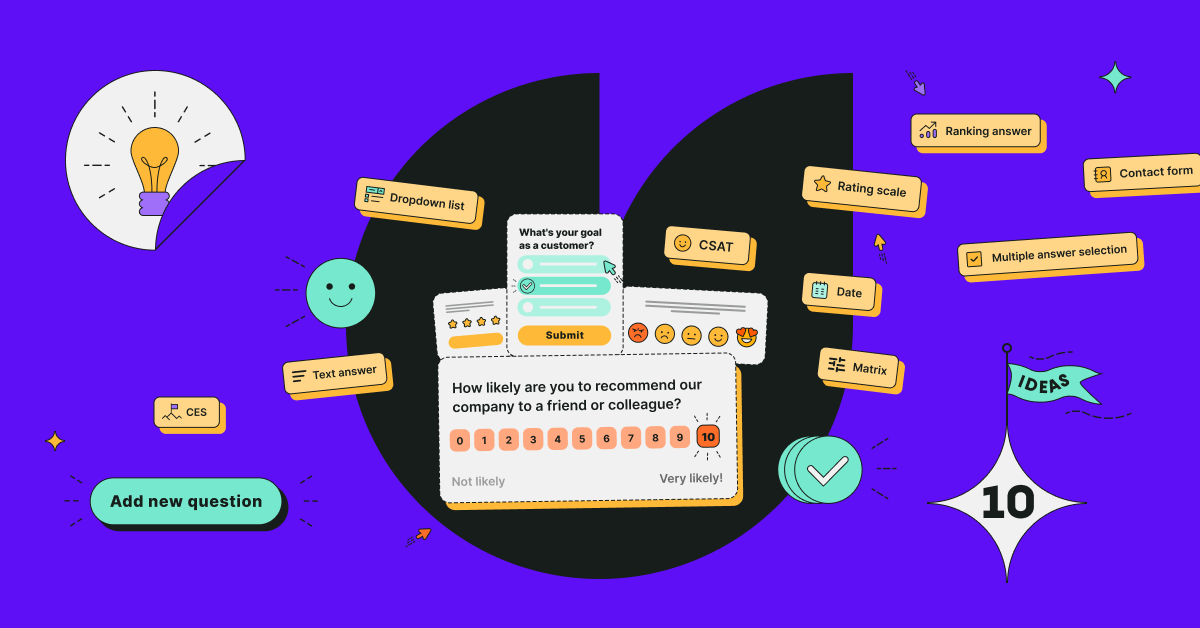

.svg)

.svg)
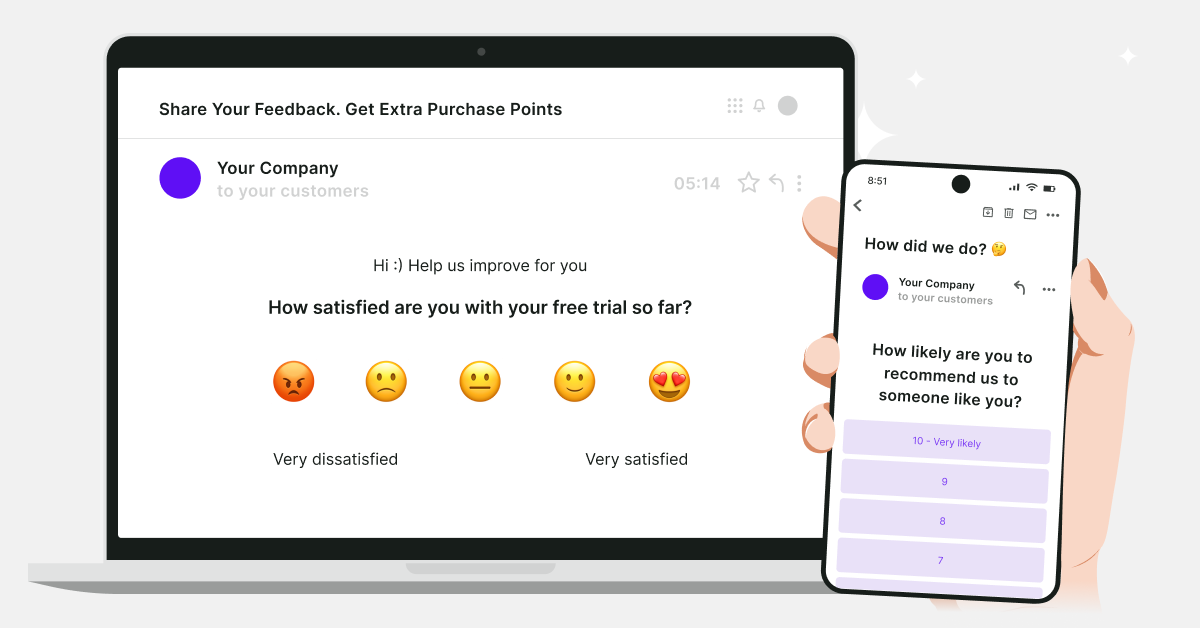
.jpg)
